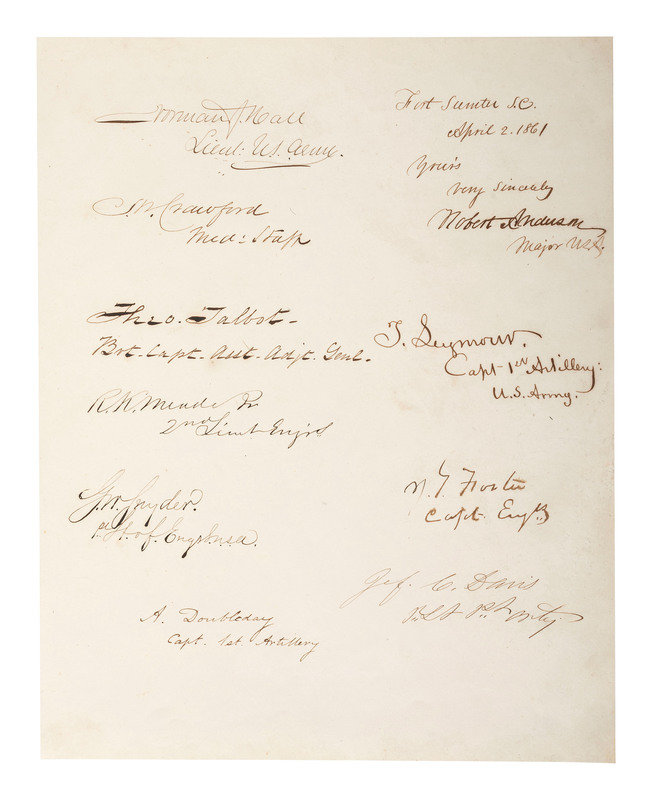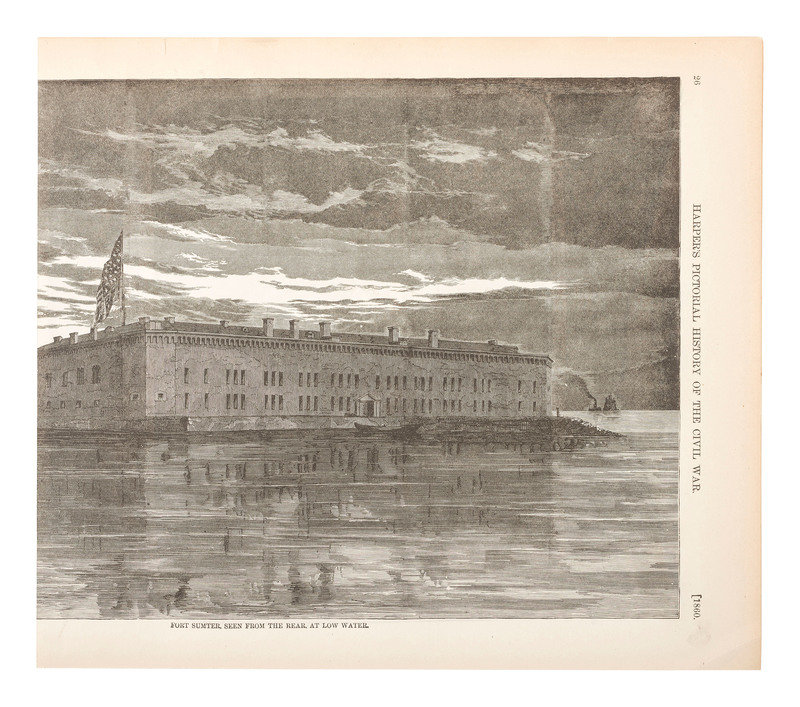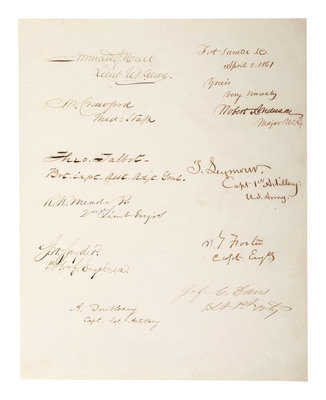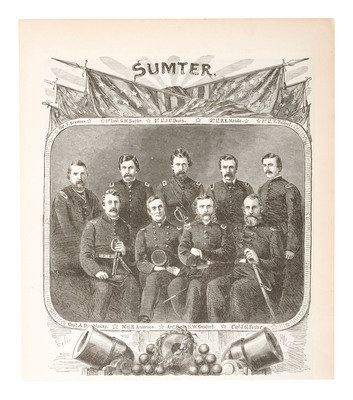[CIVIL WAR -- FORT SUMTER]. Single sheet with signatures of Robert ANDERSON and his nine officers immediately before the First Battle of Fort Sumter. Fort Sumter, SC, 2 April 1861.
Sale 1095 - American Historical Ephemera & Photography, Featuring Property from the James Milgram, M.D., Collection of Broadsides, Ephemeral Americana & Historical Documents
Day 1 Lots 1-403
Nov 3, 2022
10:00AM ET
Day 2 Lots 404-634
Nov 4, 2022
10:00AM ET
Live / Cincinnati
Own a similar item?
Estimate
$4,000 -
6,000
Price Realized
$2,813
Sold prices are inclusive of Buyer’s Premium
Lot Description
[CIVIL WAR -- FORT SUMTER]. Single sheet with signatures of Robert ANDERSON and his nine officers immediately before the First Battle of Fort Sumter. Fort Sumter, SC, 2 April 1861.
1 page, approx. 8 x 10 in., very light spotting, toning.
Sheet with signatures and ranks of ten officers at Fort Sumter, signed on or about 2 April 1861 by the staff on duty when the fort was bombarded the following week.
Major Robert Anderson moved his companies of the 1st US Artillery from Fort Moultrie to the unfinished Fort Sumter in Charleston Harbor on 26 December 1860. South Carolina had seceded six days earlier and Anderson was concerned that the state would take possession of all military installations within its borders. His force was ill-equipped, with little ammunition and dwindling rations, and over the next months, Governor Pickins and General Beauregard requested the abandonment of the fort.
Major Anderson repeatedly requested instructions from Washington, but, in part because of the change in administration, nothing was forthcoming. When Lincoln took office on 4 March 1861, he was soon made aware of the situation in Charleston. From the State Department, William Seward advised against provisioning the fort, if it were even possible to do so peacefully; however Lincoln decided to try to resupply the fort with troops on a civilian steamer. The Star of the West was fired upon, however, before it reached the fort and was forced to retreat.
While Anderson and his men remained in their precarious position, apparently one soldier decided to obtain the signatures of the officers at the fort. resulting in the remarkable signature page featured here. The signatories include:
HALL, Norman J. ("Norman J. Hall, Lieut. U.S. Army.") After the surrender of Fort Sumter, Hall went home to recruit and received a commission as colonel of the 7th Michigan VI. He led the 7th Michigan at Second Manassas and in the Maryland campaign. His unit suffered 60% casualties at Antietam, and he lost over 200 men defending Cemetery Ridge at Gettysburg. The unit was instrumental in holding against "Pickett's Charge." He was cited for gallantry at Antietam, Fredericksburg, and Gettysburg. -- CRAWFORD, Samuel W. ("Crawford, Med. Staff.") Crawford was the surgeon at Fort Sumter during the bombardment. A month after the surrender, he left the medical corps and accepted a commission in the 13th U.S. Infantry. In 1862 Crawford was promoted to brigadier general and saw action in the Northern Virginia Campaign, and at Antietam and Gettusburg.
TALBOT, James Theodore. ("Theo. Talbot, Bvt. Capt. Asst. Adj. Genl.") Talbot accompanied Major General Fremont on his second and third expeditions, the former at the age of 18. In 1860, he was assigned to Fort Moultrie. He was nominated assistant adjutant general in February 1861, and was a courier taking messages between Fort Sumter and Washington during the lead-up to the bombardment. A year later he died of tuberculosis.
MEADE, Richard Kidder, Jr. ("R.K. Meade Jr., 2nd Lieut Engrs.") From a prominent Virginia family, Richard Meade was a graduate of the US Military Academy (1853) and was assigned to the Army Corps of Engineers. After the fall of Fort Sumter, he resigned from the U.S. Army and accepted a commission as major in the Confederate forces. According to Heitman, he died 31 July 1862.
SNYDER, George W. ("G.W. Snyder, 2nd Lt. of Engrs USA.") Snyder was an 1856 US Military Academy graduate, also assigned to the Army Corps of Engineers. He was in charge of the evacuation of Fort Moultrie to Sumter. After the fall of Fort Sumter he returned north still serving as an engineer. He saw action at first Manassas, but did not live to see much more of the war. Snyder died of disease in November 1861.
DOUBLEDAY, Abner. ("A. Doubleday, Capt. 1st Artillery.") Doubleday was an 1842 US Military Academy graduate, receiving a commission as a 2nd lieutenant of artillery. He served in the Mexican War and Seminole Wars before his assignment to Fort Moultrie in 1858. He was second in command at Fort Sumter and, being a captain of artillery, is credited with firing the first return shot after Beauregard's forces fired on the fort. He did see combat at Antietam and Gettysburg, but was removed from field command after the latter. He spent most of the war in Washington, and rode with Lincoln to Gettysburg for the dedication of the battlefield.
ANDERSON, Robert. ("Fort Sumter, Apr. 2, 1861, Yours, Very sincerely, Robert Anderson, Major USA.") Anderson graduated the US Military Academy in 1825 and was commissioned a 2nd lieutenant in the 3rd Artillery. He served in various regions and conflicts, including the Black Hawk War, Mexican War, and Florida, before being assigned to command the troops at Fort Moultrie in 1860. For his services at Fort Sumter, he was appointed a brigadier general. Failing health forced his retirement from active service in 1863, but he was still active in organizing the soldiers' home in Washington, which sheltered thousands of veterans. Ironically, Anderson was Beauregard's artillery instructor at West Point, and the latter became Anderson's assistant after graduation (1838).
SEMOUR, Truman. ("T. Seymour, Capt. 1st Artillery, US Army.") Seymour graduated from the US Military Academy in 1846, just in time for the Mexican War. He also spent time fighting the Seminoles in Florida before being sent to Fort Sumter. He remained in service during the war, serving in the Peninsula Campaign, and fighting at Mechanicsville, Gaines' Mill, Malvern Hill, Second Manassas, South Mountain, and Antietam before transferring to the Department of the South. After the disastrous battle of Olustee, he returned north in time for the Wilderness battles, Petersburg, and he was present at Appomattox Court House for Lee's surrender.
FOSTER, John. ("J.G. Foster, Capt. Engrs.") Foster also graduated from the US Military Academy in 1846, and served as an engineer in the Mexican War. In 1858 he was assigned to the construction of Fort Sumter in Charleston Harbor. In October of 1861 he was appointed a brigadier general of volunteers, and served with Burnside in North Carolina. He assumed command when Burnside was transferred to Virginia, and was promoted to major general in July 1862. He was transferred to the Dept. of the Ohio in 1863, but was injured shortly thereafter. When he recovered, he commanded the Dept. of the South, then Florida by the end of the war.
DAVIS, Jefferson C. ("Jef. C. Davis, 1st Lt. 1st Arty.") Born in Indiana, Davis enlisted as a volunteer during the Mexican War. He received a commission after service and joined the 1st Artillery. After the fall of Fort Sumter, he became colonel of the 22nd Indiana Volunteer Infantry Regiment before becoming a brigadier general of volunteers in December 1861. He saw action at Pea Ridge, Stones River, Chickamauga, and the Atlanta Campaign among others. He remained in service after the Civil War, gaining fame with his command of troops during the Modoc War.
----
On 11 April 1861, General Beauregard finally sent his aides with a message to Major Anderson, demanding the evacuation of the Fort. While Anderson responded that he could not comply, he informed Beauregard that he and his men would exhaust their supplies in a matter of days, forcing them to evacuate of their own necessity. Although Beauregard had suggested that he would not open fire on the fort as long as Anderson remained peaceful, he broke this entente and instructed his artillery to open fire at 4:30 A.M. on 12 April, giving Anderson one hour's notice. The Civil War had begun.
Condition Report
Auction Specialist





